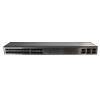-
€
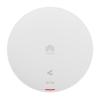

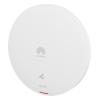






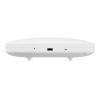
El AP661 de Huawei es un punto de acceso de la serie eKitEngine compatible con el estándar Wi-Fi 6. Admite los protocolos IEEE 802.11 b/g/n/ax en la banda de 2,4 GHz e IEEE 802.11 a/n/ac en la banda de 5 GHz. Realiza una transmisión 2x2 MIMO en la banda de 2,4 GHz y dos transmisiones en 5 GHz: 2x2 MIMO y 4x4 MIMO. El rendimiento teórico total máximo es de 6600 Mbps. El dispositivo admite MU-MIMO (transmisión y recepción simultáneas de datos de varios usuarios) y BSS coloring (marcado de transmisiones para reducir las interferencias). El punto de acceso tiene una antena inteligente, cuyo diseño consta de múltiples elementos que pueden funcionar independientemente. Los elementos de la antena pueden modificar la forma del haz principal según sea necesario y adaptarse a los clientes conectados. El AP661 está diseñado para ubicaciones multiusuario. Es capaz de manejar múltiples dispositivos cliente conectados sin que se degrade el rendimiento de la red. La carcasa se ha diseñado para su montaje en pared, techo o carril guía con ranura en T. El dispositivo dispone de 1 puerto Ethernet 2,5G (10/100/1000/2500 Mbps) y 1 puerto Gigabit Ethernet (10/100/1000 Mbps). Puede alimentarse mediante PoE en el estándar 802.3 o mediante una toma de CC (12 V).
El producto que se ofrece puede funcionar en varios modos: Fat AP, Leader AP, Fit AP o Cloud. En el modo Fat AP, el dispositivo funciona como un dispositivo independiente; puede configurarlo como un router inalámbrico normal. El modo Leader AP permite configurar el AP661 como dispositivo maestro (líder) para gestionar otros puntos de acceso compatibles. El modo Cloud permite al dispositivo conectarse a un controlador situado en la nube, y el modo Fit AP se utiliza para conectarse a otro controlador WLAN AC físico. Las soluciones de la serie eKitEngine le permitirán crear una red inalámbrica extensa y eficaz, que puede cubrir zonas muy amplias con su alcance. Los dispositivos admiten itinerancia de datos, control de ancho de banda y múltiples métodos de autenticación. El AP661 es ideal para ubicaciones con potencial para múltiples usuarios, como salas de reuniones, salas de conciertos y salas de exposiciones.
Red inalámbrica Wi-Fi 6 AX6600, Bluetooth
El AP661 tiene capacidad Wi-Fi 6, compatible con los protocolos IEEE 802.11 b/g/n/ax en la banda de 2,4 GHz e IEEE 802.11 a/n/ac/ax en la banda de 5 GHz. El dispositivo puede realizar 3 transmisiones de radio simultáneas: 2,4 GHz 2x2 MIMO, 5 GHz 2x2 MIMO y 5 GHz 4x4 MIMO - 2 + 2 + 4. Esto da un rendimiento teórico máximo de 574 Mbps en 2,4 GHz, 1201 Mbps en 5 GHz 2x2 MIMO y 4804 Mbps en 5 GHz 4x4 MIMO. Estas altas velocidades funcionarán especialmente bien en zonas diseñadas para varios usuarios al mismo tiempo. El AP661 proporcionará un rendimiento adecuado en situaciones en las que los AP estándar no podrían ofrecer velocidades de transmisión suficientemente rápidas a los clientes.
El punto de acceso también utiliza una serie de funciones adicionales para mejorar la calidad de la red. MU-MIMO permite a varios clientes transmitir y recibir simultáneamente, eliminando las colas de datos. Beamforming se utiliza para dar forma al haz y mejorar la conectividad con los dispositivos situados en el borde de la cobertura, y TWT ahorra energía despertando los dispositivos conectados sólo cuando se establece una transmisión.
Además, el dispositivo admite transmisión Bluetooth (BLE 5.2), que puedes utilizar para gestión remota, localización o IoT, entre otras cosas.
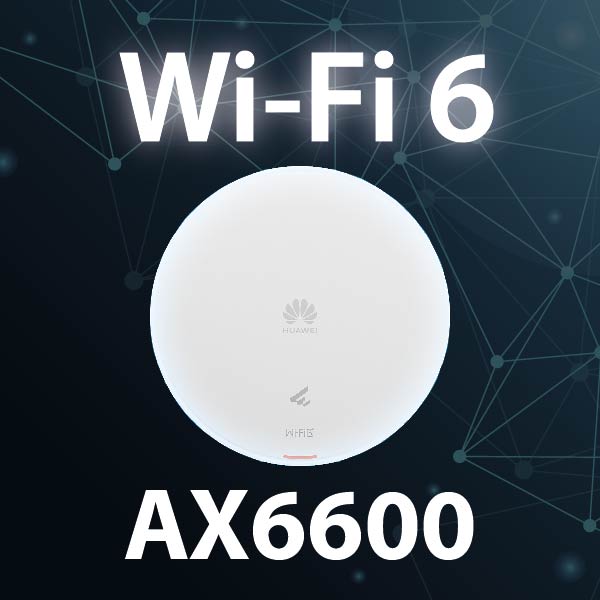

Puerto 2.5G Ethernet, puerto 1G Ethernet, puerto USB, fuente de alimentación PoE, toma de DC
El producto ofrecido está equipado con un puerto Ethernet 2,5G (10/100/1000/2500 Mb/s) y un puerto Gigabit Ethernet (10/100/1000 Mb/s). El puerto 2,5G sirve simultáneamente como entrada de alimentación PoE de acuerdo con la norma IEEE 802.3 at, pero también puede suministrar alimentación mediante una toma de DC estándar (12 V). El consumo máximo de energía, sin incluir USB, es de 21,2 W.
El fabricante utilizó un puerto USB con la idea de usarlo para conectar un módem externo compatible con IoT, como ZigBee o RFID.
Antenas Smart
El punto de acceso tiene antenas smart, el diseño de la antena consiste en múltiples elementos que pueden funcionar independientemente unos de otros. Los elementos de antena pueden modificar la forma del haz principal según sea necesario para ofrecer la mejor cobertura posible a los clientes conectados. El dispositivo se adapta a las condiciones de radio y proporciona una cobertura de señal mucho mejor que los AP equipados con antenas omnidireccionales ordinarias. La ganancia de energía es de 4 dBi en la banda de 2,4 GHz y de 5 dBi en la de 5 GHz.
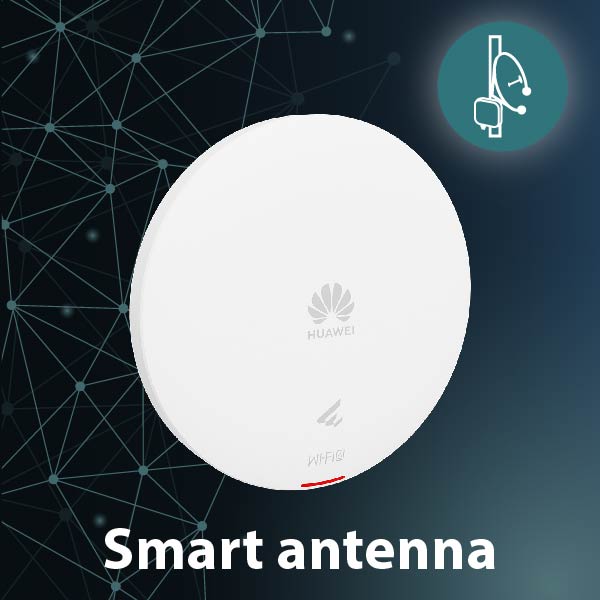

Hasta 1536 clientes
El Huawei AP661 puede dar servicio hasta a 1536 clientes (512 / radio), y ha sido diseñado para ubicaciones muy difíciles, como pabellones de ferias y conciertos. El fabricante sugiere que el punto de acceso dé servicio a un máximo de 300 clientes simultáneamente. En esta configuración, es capaz de proporcionar un ancho de banda de unos 22 Mbps a cada uno de ellos, lo que es bastante suficiente para un uso estándar de Internet. El sistema admite el equilibrio de carga y la itinerancia inteligente; si un punto de acceso está sobrecargado, los usuarios se cambian a otro.
El algoritmo DFA se utiliza para detectar automáticamente el consumo de canales inalámbricos y reconocer las transmisiones solapadas. Cuando se utilizan varios puntos de acceso, funcionan de tal manera que no interfieren entre sí. Además, las tecnologías EDCA y de programación del tiempo de emisión permiten programar el uso de los canales por un determinado dispositivo cliente, de modo que cada dispositivo tenga el mismo acceso a la red.
Una ventaja importante del sistema eKitEngine basado en AP es la optimización de la utilización de la red por los dispositivos cliente. Los clientes con poca cobertura o una velocidad de conexión demasiado baja se desconectan automáticamente para mejorar la calidad general de la transmisión. El AP661 también dispone de una función 5G-prior: los dispositivos cliente se conectan principalmente en la banda de 5 GHz para garantizar que disponen del mejor ancho de banda posible. Esto reduce significativamente la carga y las interferencias en la banda de 2,4 GHz.
Sistema inalámbrico avanzado
El producto ofrecido está diseñado para funcionar en un gran sistema inalámbrico compuesto por muchos puntos de acceso. Una red creada de este modo es capaz de cubrir incluso zonas muy extensas, en función del número de dispositivos utilizados. El sistema admite la itinerancia de datos; los usuarios pasan automáticamente de un punto de acceso a otro sin perder la conexión.
Las soluciones de Huawei ofrecen un gran número de funciones relacionadas con el control del ancho de banda, la mejora de la calidad de transmisión y la seguridad. Para la autenticación de usuarios, puede utilizar 802.1x, dirección MAC o portal cautivo, entre otros. El avanzado sistema de gestión y supervisión del rendimiento le permitirá reducir el tiempo que dedica a administrar la red, por ejemplo, detectando y reconociendo automáticamente distintos tipos de errores.


Cuatro modos de funcionamiento
El punto de acceso puede funcionar en cuatro modos:
- Fat AP: el punto de acceso funciona por sí solo, la configuración y la gestión son similares a las de los routers inalámbricos estándar. Funcionará bien en redes pequeñas en las que solo se utilice un AP.
- Leader AP: permite configurar el dispositivo como "líder" y asumir así la función de controlador en la red. En el modo Leader AP, puedes conectar otros puntos de acceso al dispositivo para crear un sistema extenso. Este modo es el más adecuado para redes pequeñas, por ejemplo en oficinas o restaurantes. Reduce los costes asociados a la compra de un controlador adicional..
- Cloud AP: en este modo, puede gestionar el punto de acceso desde una plataforma disponible en la nube. Esta plataforma facilita enormemente la supervisión del funcionamiento y la realización de preconfiguraciones, y no requiere dispositivos de gestión adicionales.
- Fit AP: este es el modo básico de funcionamiento en el que el punto de acceso se conecta al controlador.
Múltiples aplicaciones
El Huawei AP661 funcionará mejor en lugares donde se espera un gran número de usuarios al mismo tiempo, como salas de conciertos y salas de exposiciones. El alto rendimiento significa que incluso con un gran número de clientes, el dispositivo puede entregar la transmisión de todos a velocidad suficiente. El AP661 es compatible con numerosas funciones de última generación, y hará frente a ubicaciones muy difíciles en las que el rendimiento de otros puntos de acceso es insuficiente.

Especificación
| Huawei AP661 | |
| Características generales | |
|---|---|
| Montaje |
En la pared En el techo En el carril guía con riel en T |
| Dimensiones | Φ 220 mm x 50 mm |
| Peso | 1,08 kg |
| Puertos Ethernet |
1 puerto 2.5G Ethernet 10/100/1000/2500 Mb/s
1 puerto 1G Ethernet 10/100/1000 Mb/s
1 puerto USB |
| Bluetooth | BLE 5.2 |
| Diodos LED | El diodo indica encendido, dispositivo encendido, dispositivo encendido, alarma y errores del sistema. |
| Características de la fuente de alimentación | |
| Alimentación de entrada |
Entrada DC: 12 V ± 10% PoE: en la norma IEEE 802.3 at |
| Consumo máximo | 21,2 W (excepto USB) |
| Propiedades medioambientales | |
| Temperatura de funcionamiento admisible | De -10 a 50 grados Celsius |
| Temperatura de almacenaje admisible | De -40 a 70 grados Celsius |
| Humedad del aire admisible | 5%-95% sin condensación |
| Grado de protección | IP41 |
| Propiedades de la radio | |
| Tipo de antena | Antenas Smart integradas |
| Aumento de energía |
2,4 GHz: 4 dBi 5 GHz: 5 dBi |
| Número máximo de SSID por radio | ≤ 16 |
| Número máximo de clientes | ≤ 1536 (512/radio) |
| Potencia máxima de transmisión |
2,4 GHz: 25 dBm 5 GHz (2x2 MIMO): 23 dBm 5 GHz (4x4 MIMO): 26 dBm BLE: < 10 dBm (la potencia depende de las condiciones legales locales) |
| Control de potencia | Precisión a 1 dBm |
| Número máximo de canales no solapados |
2.4 GHz (2.412 GHz - 2.472 GHz) 802.11 b/g
802.11 n
802.11 ax
5 GHz (5.18 GHz - 5.825 GHz) 802.11 a
802.11 n
802.11 ac
802.11 ax
|
| Modo Fat/Fit AP | |
| Características WLAN |
Estándares IEEE 802.11 b/g/n/ax (2,4 GHz) / IEEE 802.11 a/n/ac/ax (5 GHz) MRC (Maximum Ratio Combining) STBS (Space Time Block Code) CDD (Cyclic Delay Diversity) / CSD (Cyclic Shift Diversity) Beamforming (formación de haces) MU-MIMO (Multi-user multiple-input multiple-output) OFDMA (Orthogonal frequency division multiple access) Modulación hasta 1024QAM, también admite 256QAM, 64QAM, 16QAM, 8QAM, QPSK i BPSK TWT (Target wake time) LDPC (Low-density parity-check) Frame aggregation, de los cuales A-MPDU (Tx/Rx) y A-MSDU (Tx/Rx) 802.11 DFS (dynamic frequency selection) GI (Short guard interval) en modos 20, 40, 80 i 160 MHz Asignación de prioridades y programación según WMM (Wi-Fi multimedia) Gestión de canales WLAN Búsqueda automática de canales y prevención de interferencias Ocultación de SSID SST (Signal sustain technology) U-APSD (Unscheduled automatic power save delivery) Soporte CAPWAP en el modo de Fit AP (Control and Provisioning of Wireless Access Points) Registro automático en modo Fit AP ESS en modo Fit AP (Extended Service Set) ACC (Advanced cellular coexistence) para minimizar el impacto de las interferencias Multi-user CAC (call admission control) Smart roaming 802.11k / 802.11r Fast roaming 802.11r (≤ 50 ms) |
| Características de la red |
Estándar IEEE 802.3ab Negociación automática de la velocidad de conexión, cruce automático MDI/MDIX Estándar IEEE 802.1q Asignación de SSID a VLAN VLAN troncal en puertos Ethernet de enlace ascendente Canal de gestión en el puerto de enlace ascendente en modo etiquetado y no etiquetado Admite tunnel data forwarding y direct data forwarding Identificación de aplicaciones y clasificación QoS en modo de reenvío directo para mejorar la calidad de la transmisión de audio. Aislar a los clientes en una VLAN Control de acceso IPv4 / IPv6 (ACL) LLDP (Link Layer Discovery Protocol) Soporte de canal CAPWAP en modo Fit AP Autenticación de controlador unificada en modo Fit AP Compatibilidad con AC dual-link backup en modo Fit AP NAT (Network Address Translation) en modo Fat AP IPv6 en modo Fit AP Telemetría en modo Fit AP: lectura rápida del estado de funcionamiento del AP IPv6 SAVI (Source Address Validation Improvements) Soft GRE (Generic Routing Encapsulation) Protocolo mDNS (Multicast Domain Name Service) |
| Funkcja QoS |
Ahorro de energía WMM Asignación de prioridades para paquetes de enlace ascendente, asignación basada en flujos para paquetes de enlace descendente Asignación y programación de colas Límite de ancho de banda según el usuario Gestión adaptativa del ancho de banda (ajuste del ancho de banda en función del número de usuarios y las condiciones de radio) Airtime scheduling Air interface HQoS scheduling Mejora de la transmisión de juegos para móviles y VR Intelligent multimedia scheduling |
| Seguridad |
Autenticación open system Cifrado/autenticación WEP con clave de 64, 128, 152 o 192 bits WPA2-PSK (WPA2-Personal) WPA2-802.1X (WPA2-Enterprise) WPA3-SAE (WPA3-Personal) WPA3-802.1X (WPA3-Personal) WPA-WPA2 hybrydowe uwierzytelnianie WPA2-WPA3 hybrydowe uwierzytelnianie WPA2-PPSK w trybie Fit AP WAPI WIDS (Wireless intrusion detection system) y WIPS (Wireless intrusion prevention system), detección de dispositivos no autorizados, detección de ataques, listas negras dinámicas y listas negras y blancas de clientes/AP. Autenticación 802.1X, MAC, Portal DHCP Snooping DAI (Dynamic ARP Inspection) IPSG (IP Source Guard) 802.11w PMF (Protected Management Frames) Cifrado de hardware IPsec i DTLS |
| Control de las operaciones |
Supervisión y gestión unificadas en el controlador, en modo Fit AP Inicio de sesión automático, carga de configuración (plug&play) en modo Fit AP Actualización de grupos en modo Fit AP Telnet STelnet mediante SSHv2 SFTP mediante SSHv2 Acceso remoto a través de Bluetooth Gestión web mediante HTTP/HTTPS en modo Fat AP Supervisión en directo, detección rápida de fallos mediante NMS SNMP v1/v2/v3 en modo Fat AP Alarma de estado del sistema NTP (Network Time Protocol) en modo Fat AP |
| Localización |
Localización del terminal cliente Colaboración con el servidor de localización para localizar dispositivos no autorizados (sólo en modo Fit / Cloud AP) |
| BYOD |
Identificación de dispositivos que utilizan OUI en la dirección MAC Identificación de dispositivos utilizando UA en el paquete HTTP Identificación de dispositivos basada en opciones DHCP El servidor RADIUS proporciona políticas de reenvío de paquetes, seguridad y QoS según el tipo de dispositivo proporcionado en la autenticación RADIUS (sólo en modo Fit AP) |
| Análisis del espectro |
Identificación de varios tipos de interferencias, como dispositivos Bluetooth, hornos microondas, teléfonos inalámbricos, dispositivos ZigBee, mandos de juegos, niñeras electrónicas y otros. Funciona con un servidor de localización para localizar fuentes de interferencias (sólo en modo Fit AP) |
| Modo Cloud | |
| Características WLAN |
Estándares IEEE 802.11 b/g/n/ax (2,4 GHz) / IEEE 802.11 a/n/ac/ax (5 GHz) MRC (Combinación de máxima relación) STBS (Código de bloques espacio-temporales) CDD (diversidad de retardo cíclico) / CSD (diversidad de desplazamiento cíclico) Beamforming (Formación del haz) MU-MIMO (multiusuario, entrada múltiple, salida múltiple) OFDMA (Acceso múltiple por división de frecuencias ortogonales) Modulación hasta 1024QAM, también admite 256QAM, 64QAM, 16QAM, 8QAM, QPSK y BPSK TWT (tiempo de activación del objetivo) LDPC (comprobación de paridad de baja densidad) Agregación de tramas, incluyendo A-MPDU (Tx/Rx) y A-MSDU (Tx/Rx) 802.11 DFS (selección dinámica de frecuencia) GI (intervalo de guarda corto) en modos de 20, 40, 80 y 160 MHz Asignación de prioridades y programación según WMM (Wi-Fi multimedia) Gestión de canales WLAN Búsqueda automática de canales y prevención de interferencias Ocultación de SSID SST (tecnología de mantenimiento de la señal) U-APSD (ahorro de energía automático no programado) Registro automático de AP Itinerancia inteligente 802.11 k y 802.1 v Itinerancia rápida 802.11 r (≤ 50 ms) ACC (coexistencia celular avanzada), que minimiza el impacto de las interferencias de las redes celulares |
| Características de la red |
Estándar IEEE 802.3ab Negociación automática de la velocidad de conexión, cruce automático MDI/MDIX Estándar IEEE 802.1q Asignación de SSID a VLAN Cliente DHCP, adquisición de direcciones IP mediante DHCP Aislamiento de clientes en una única VLAN Lista de control de acceso (ACL) Autorización unificada en la plataforma en nube NAT Telemetría, adquisición rápida del estado y los parámetros del AP |
| Funciones QoS |
Ahorro de energía WMM Asignación prioritaria de paquetes ascendentes, asignación basada en flujos de paquetes descendentes Asignación y programación de colas Limitación basada en el usuario Programación Aitrime Programación HQoS de la interfaz aérea Mejora de la transmisión de juegos móviles y de RV |
| Seguridad |
Autenticación open system Cifrado/autenticación WEP con clave de 64, 128, 152 o 192 bits WPA2-PSK (WPA2-Personal) WPA2-802.1X (WPA2-Enterprise) WPA3-SAE (WPA3-Personal) WPA3-802.1X (WPA3-Personal) WPA-WPA2 autenticación híbrida WPA2-WPA3 autenticación híbrida WPA2-PPSK en modo Fit AP Autenticación 802.1X, MAC, Portal DHCP Snooping DAI (Dynamic ARP Inspection) IPSG (IP Source Guard) |
| Supervisión de operaciones |
Supervisión y gestión unificadas en la plataforma en nube Inicio de sesión automático, carga de la configuración (plug&play) Actualización de grupos Telnet STelnet mediante SSHv2 SFTP mediante SSHv2 Gestión inalámbrica Bluetooth Gestión web local mediante HTTP/HTTPS o NMS Supervisión en directo, detección rápida de fallos a través de NMS Alarma de estado del sistema NTP (Network Time Protocol) |






 Polski
Polski English
English Italiano
Italiano Español
Español Čeština
Čeština Српски
Српски Deutsch
Deutsch Ελληνικά
Ελληνικά Slovenský
Slovenský

